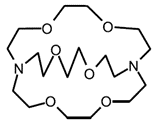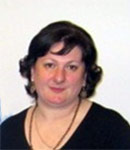ქიმიის ტერმინთა განმარტებითი ლექსიკონი
- ინგლისურ-ქართული
- ქართულ-ინგლისური
- ლექსიკონის შესახებ
- გამოხმაურება

| cryptand | კრიპტანდი |
| A molecular entity comprising a cyclic or polycyclic assembly of binding sites that contains three or more binding sites held together by covalent bonds, and which defines a molecular cavity in such a way as to bind (and thus ′hide′ in the cavity) another molecular entity, the guest (a cation, an anion or a neutral species), more strongly than do the separate parts of the assembly (at the same total concentration of binding sites). The adduct thus formed is called a ′cryptate′. The term is usually restricted to bicyclic or oligocyclic molecular entities. Example:
|
მოლეკულური ერთეული, რომელიც მოიცავს სამი ან მეტი კოვალენტური ბმით დამაკავშირებელი უბნის მქონე ციკლურ ან პოლიციკლურ ლიგანდს და რომელიც წარმოქმნის მოლეკულურ ღრუს ისე, რომ უფრო ძლიერად იკავშირებს (და ამით ღრუში „დამალავს″) სხვა მოლეკულურ ერთეულს, სტუმარს (კატიონი, ანიონი ან ნეიტრალური ნაწილაკი), ვიდრე მისი ცალკეული ნაწილები (დაკავშირების ადგილების იმავე მთლიანი კონცენტრაციით). ამგვარად წარმოქმნილ დანამატს „კრიპტატი″ ეწოდება. ტერმინი ჩვეულებრივ შემოიფარგლება ბიციკლური ან ოლიგოციკლური მოლეკულური ერთეულებით. მაგალითი:
|
| See also: host | ასევე იხილეთ: მასპინძელი |
Source | წყარო:
|
|









